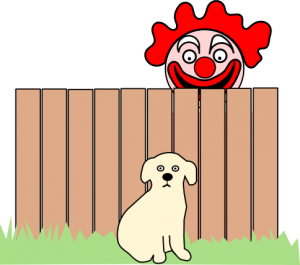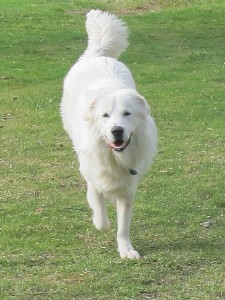Good dog! Most of us have expressed our approval with a certain individual more than once in this way. Sometimes this phrase is used as reinforcement for desired behaviour and sometimes it is more of a general praise, not specifically linked to anything the dog is doing at that moment. But what exactly qualifies a dog or their behaviour as “good”? We all have our own ideas about what we like and don’t like about dogs, but it is worth putting our picture of the “ideal dog” into perspective. After all it is human ideas and expectations that will largely determine a dog’s quality of life.
The obedient dog
Traditionally, from a dog training perspective, a good dog is one that is obedient and follows his master’s every command. A good dog has no annoying habits such as excessive barking, jumping up, pulling on lead, house-soiling, chewing, digging or being aggressive towards the wrong target. Dogs with “jobs”, such as working, racing or assistance dogs, have to satisfy even stricter requirements and many don’t make the cut. In fact, a great many domestic dogs do not live up to human expectations and suffer neglect, abandonment, abuse or an untimely death.
This is not the dogs’ fault. Historically, breeding and training dogs was rarely done with the dogs’ best interests in mind. Our zealous attempt to create the perfect dog for various applications has caused substantial suffering in dogs and common behaviour problems are often of our own making. Selective breeding did not just fashion – and sometimes burden – dogs with exaggerated anatomical features, but also contributed to a range of mental and physical health issues which impact on our dogs’ behaviour. Training has its own shameful history of torturing and subjugating dogs which continues to this day – albeit under various disguises – and has to take the blame for countless fearful, aggressive and otherwise emotionally damaged dogs. Sometimes the damage – no matter if it was largely genetic, environmental or both in origin – cannot be undone through training or veterinary intervention. These dogs will never be “good” in anybody’s books. They are the losers of ruthless breeding and wild-west-style training methods. And with the law being largely silent in both industries – dog breeding and dog training – we will have to deal with preventable behaviour problems in dogs for quite a while yet.
The educated dog
What would greatly help our dogs, but also benefit us, is a shift away from the traditional notion of the “obedient dog” as a role model. Allowing dogs to freely express their personality and, to an extent, make their own decisions might just be the best way forward in the world of dog training. This does not mean that we forgo safety and let our dogs run wild. It means that we give our dogs the skills to happily live within human society without constantly having to tell them what to do. It means that we ask ourselves not just what we teach a dog but why. Too many dogs are taken through the usual rigmarole of obedience exercises at dog training schools or at home without being taught how to make use of those skills to access all the things they want in life. Although training can be beneficial for dogs in itself – think mental exercise akin to a crossword puzzle – it is usually linked to a goal. Humans mostly train dogs for the purpose of having more control over them. However, a much better and more contemporary definition of dog training would be “canine education”. Education is liberating, because it gives individuals knowledge they can use to improve their lives. If we look at it from that perspective, dog training is no longer about humans controlling dogs but about dogs learning how to control their own lives.
Modern dog training classes that aim to teach dogs “life skills” or turn them into “canine citizens” are positive signs that we have already started to change our thinking. The trend is away from militaristic drills and boot camps which aim to turn dogs into robotic obedience machines towards a more holistic and cooperative learning experience for the dog-human team. It is a persistent myth that a dominance-submission relationship is needed to create harmony between human and dog, but slowly awareness is growing that this approach is risky and unnecessarily stressful for everyone involved. Harmony does not arise from intimidation and coercion, no matter how subtle this is executed. Good behaviour does not come from stress and tension. Fear of punishment is a potential time bomb and creates a volatile individual, not a relaxed and friendly one.
Armed with this knowledge, many progressive dog trainers continually develop better and more humane educational programs for dogs and their people. It will be interesting to see how we can take this even further over the next decades or so.
The happy dog
Ultimately it is up to every dog’s guardian to decide what it is they want from their dog. However, animal welfare concerns should challenge us all to think beyond our own needs and give consideration to the dog’s needs and quality of life.
Compulsive behaviours, anxiety and aggression are signs that not all is well regarding the dog’s mental and physical health. In order to prevent these problems from developing or getting worse, we need to learn and be aware of how our own behaviour affects dog behaviour, be that through specific actions, tone of voice, body language or otherwise. What is it we do that enables, triggers, maintains or worsens a dog’s behaviour? We can all help to make the community safer and dogs and their humans happier by protecting dogs from being coerced, intimidated or hurt in the name of dog training or otherwise.
A good dog is not the one who sits in the corner too afraid to move for fear of punishment. A good dog is not the one who has stopped barking because of the obnoxious citronella collar around her neck. A good dog is not the one who doesn’t jump up anymore because his people knocked the enthusiasm out of him. A good dog is not the one who trots along listlessly because they were yanked and strangled for pulling. These are all stressed dogs and, unfortunately, there are far too many of them. It’s time that these “good dogs” of old become a dying breed. That’s why we all need to educate ourselves to create many more happy dogs – because a happy dog is a good dog.



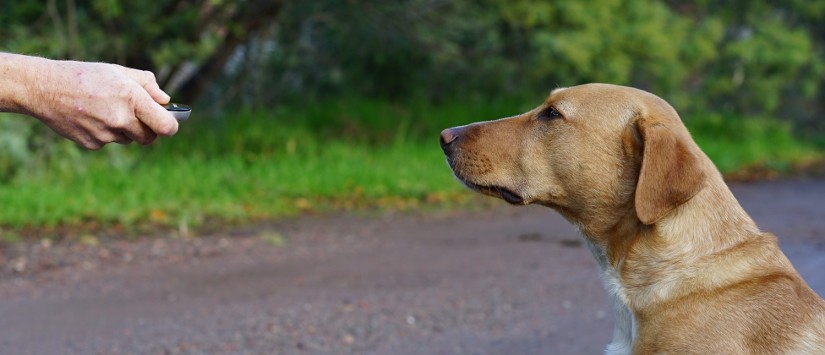
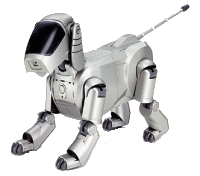
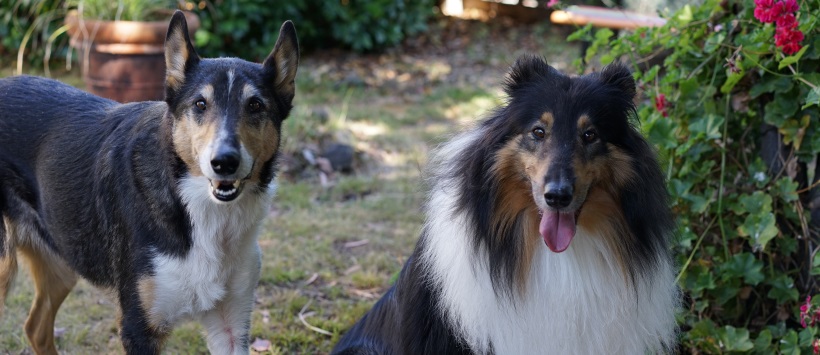
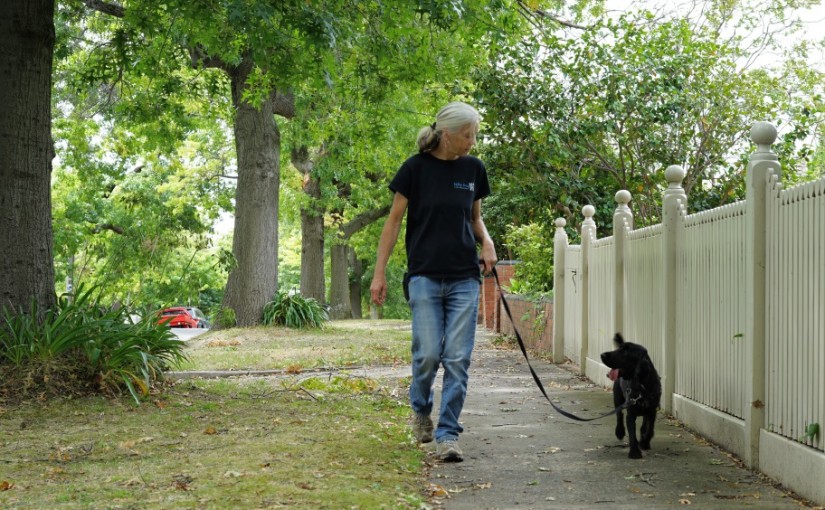
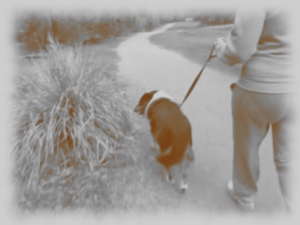 What most people envision or hope for when walking their dog is a picture of harmony: The dog leisurely strolling along next to them, no pulling, no zigzagging, and no charging at other dogs or people. Unfortunately, adjusting to their human’s pace is something that dogs rarely do by default. To rectify this, the dog training profession has come up with a range of measures from choke chains and prong collars to various harnesses and head halters. Equipment of that type can be more or less successful in thwarting the dog’s efforts to follow their own agenda, but it doesn’t necessarily result in harmony. A better, more cooperative approach is leash training.
What most people envision or hope for when walking their dog is a picture of harmony: The dog leisurely strolling along next to them, no pulling, no zigzagging, and no charging at other dogs or people. Unfortunately, adjusting to their human’s pace is something that dogs rarely do by default. To rectify this, the dog training profession has come up with a range of measures from choke chains and prong collars to various harnesses and head halters. Equipment of that type can be more or less successful in thwarting the dog’s efforts to follow their own agenda, but it doesn’t necessarily result in harmony. A better, more cooperative approach is leash training.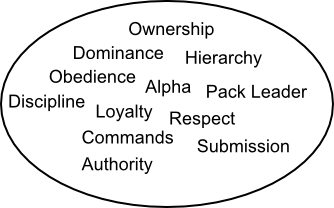
 Giving a puppy as a Christmas present is a bad idea. Why? Well, think about what you are really giving: A commitment to love and care for a high maintenance animal over a period of 10 – 15 years or more. It means a significant investment of time to provide daily companionship and exercise, spending time, money and effort on dog training, paying veterinary bills, registration and insurance, buying toys and equipment, paying for boarding and grooming and so on. Is this your intention? And, if so, how confident are you that the recipient will happily show this sort of responsibility and commitment to the dog? And bear in mind that this person might be you.
Giving a puppy as a Christmas present is a bad idea. Why? Well, think about what you are really giving: A commitment to love and care for a high maintenance animal over a period of 10 – 15 years or more. It means a significant investment of time to provide daily companionship and exercise, spending time, money and effort on dog training, paying veterinary bills, registration and insurance, buying toys and equipment, paying for boarding and grooming and so on. Is this your intention? And, if so, how confident are you that the recipient will happily show this sort of responsibility and commitment to the dog? And bear in mind that this person might be you.